| Pages:
1
2 |
Pyro
International Hazard
    
Posts: 1305
Registered: 6-4-2012
Location: Gent, Belgium
Member Is Offline
Mood: No Mood
|
|
Making I2 with NO2, success
Hello everyone,
A few days ago I had success making I2 by passing NO2 through a solution of KI, this has a few advantages over the HCl, H2O2 and other methods. It
doesn't use expensive H2O2, just nitric acid, sugar and KI. and it produces KNO2, a useful reagent.
ORIGINS OF THE IDEA
I got the idea for this when Plante1999 and I were talking and I mentioned I needed NaNO2, So he suggested I react KI and NO2. he told me he got this
idea from reading about nitrous acid being used to react with iodide making NO and iodine. NO reacted with NO2 to mke nitrite. So he thought about
using NO2 as the oxidant to get almost all nitrite so that the formed nitric and nitrous acid make NO as well when oxidizing iodine and the NO would
react with NO2 to make nitrite.
for NO2 production sugar is best as it wastes none of the available nitrogen
thanks to DJF90 for providing plante1999 with this process
2NO2+2KI->2KNO2+I2.
The KNO2 can be recuperated by boiling down the filtrate after filtering out the I2.
MY SETUP
I set up an NO2 generator with a flask and vacuum takeoff adapter with a hose and pipette leading into a cold solution of KI on a stirplate.
The first time i made a little mistake and put too much sugar into my nitric acid and had masses of NO2  . my entire lab was full of it but I had my I2 really quick. . my entire lab was full of it but I had my I2 really quick.
The second time I got my NO2 production under control and that is where these pics are from
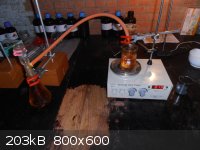
1)the setup I used, to the right of my hotplate you can see my yield of I2 from 100g KI, it is about 60-70g It isn't dry yet.
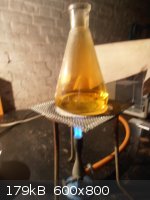
2)I used sugar and nitric acid to make NO2. but since it needed heating and my hotplate was occupated I got to use my new bunsen burner  may it never run out of gas may it never run out of gas 
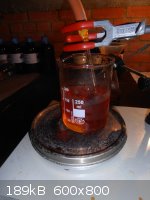
3)this is how I lead NO2 through my solution, it would be a good idea to wrap something protective over that clamp. mine is quite discoulored from all
the I2 and a little NO2
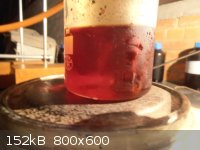
4)this is my KI solution after approx. 220s
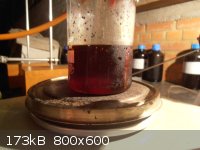
5)this is the KI solution after approx. 600s
I havn't been able to finish this run, I will finish it and post more pics this week end.
EXPERIMENTAL:
required equipment:
-Gas generator (flask, gas takeoff adapter or vacuum takeoff adapter and a stopper)
-hose (NO2 resistant, I used a gas hose made for propane)
-beaker (400ml)
-pipette or even better a fritted bubbler
-clamps
-A way to filter out the I2
required reagents:
-166g Potassium iodide (KI)
-150ml distilled water
-a means of generating 1mol NO2 (36 HNO3+C12H22O11=6 H2C2O4+23 H2O+36 NO2) so you need about 65g 100% HNO3, you need to figure out how much more
diluted HNO3 you will need. And about 10g C12H22O11(sugar)
Start by dissolving the KI in the cold water,
then put all your HNO3 and a few grams of sugar into your gas generator. (DO NOT put in more sugar! otherwise you will have a disaster on your hands
like I did)
put the hose onto a pipette or a fritted bubbler and into the solution. put the other side onto the gas takeoff adapter. then heat your flask of sugar
and nitric acid until it has reached reaction temperature, then quickly put the gas takeoff adapter unto it and clamp it in place. now whenever the
NO2 production slows add a few more grams of sugar until it all has reacted away.
now you should have a pulpy solution of iodine and aqueous KNO2. filter out the iodine and wash it with a tiny amount of water. set this out to dry
and recrystallize if you want.
now boil down the solution of KNO2 and I2 until you start seeing crystals forming at the top. then cool it down in the freezer to get as much KNO2 out
as possible.
Thanks to Plante1999 for this process!
and thanks to DJF90 for providing the source of the reaction
[Edited on 8-11-2012 by Pyro]
all above information is intellectual property of Pyro.  |
|
|
elementcollector1
International Hazard
    
Posts: 2684
Registered: 28-12-2011
Location: The Known Universe
Member Is Offline
Mood: Molten
|
|
Very nice, but 3% H2O2 isn't exactly expensive compared to nitric acid, and I use 3% pharmacy stock for all my iodine syntheses.
Elements Collected:52/87
Latest Acquired: Cl
Next in Line: Nd
|
|
|
Hexavalent
International Hazard
    
Posts: 1564
Registered: 29-12-2011
Location: Wales, UK
Member Is Offline
Mood: Pericyclic
|
|
Nice work, Pyro!
The only disadvantage I guess is that nitric acid, a somewhat difficult to acquire reagent, is used, as well as the toxicity of the
NOx.
"Success is going from failure to failure without loss of enthusiasm." Winston Churchill
|
|
|
Pyro
International Hazard
    
Posts: 1305
Registered: 6-4-2012
Location: Gent, Belgium
Member Is Offline
Mood: No Mood
|
|
true. but my HNO3 costs 2 eur/l for 60% lab grade. you are right about the toxicity of the NO2, It ruined my keck clip and left me breathing badly for
the entire next day. though if you are careful and don't put in too much sugar into your HNO3 like I did 
you shouldn't have too much trouble as the NO2 reacts almost completely with the KI.
the upside is that you make oxalic acid, KNO2 and I2. all useful reagents.
all above information is intellectual property of Pyro.  |
|
|
Nicodem
Super Moderator
      
Posts: 4230
Registered: 28-12-2004
Member Is Offline
Mood: No Mood
|
|
Why don't you post the experimental? What is the point in posting about an experiment, with pictures even, but no experimental? If you
prepared iodine and potassium nitrite with a single preparation, then I'm sure some will be interested about the procedure.
…there is a human touch of the cultist “believer” in every theorist that he must struggle against as being
unworthy of the scientist. Some of the greatest men of science have publicly repudiated a theory which earlier they hotly defended. In this lies their
scientific temper, not in the scientific defense of the theory. - Weston La Barre (Ghost Dance, 1972)
Read the The ScienceMadness Guidelines!
|
|
|
Pyro
International Hazard
    
Posts: 1305
Registered: 6-4-2012
Location: Gent, Belgium
Member Is Offline
Mood: No Mood
|
|
ok. ill edit it
all above information is intellectual property of Pyro.  |
|
|
AJKOER
Radically Dubious
    
Posts: 3026
Registered: 7-5-2011
Member Is Offline
Mood: No Mood
|
|
Some reactions might be helpful if your interest is to have some KNO2 formed. In particular:
2 NO2 + H2O <--> HNO3 + HNO2
KI + HNO2 = HI + KNO2
KI + HNO3 = HI + KNO3
2 HI + NO2 = I2 + H2O + NO
----------------
Or, on net:
3 NO2 + 2 KI + H2O = I2 + KNO2 + KNO3 + NO + H2O
or on eliminating the common H2O:
3 NO2 + 2 KI (aq) = I2 + KNO2 (aq) + KNO3 (aq) + NO
However, as per Wikipedia (http://en.wikipedia.org/wiki/HNO3 ):
NO2 + HNO2 --> HNO3 + NO
it is bested to avoid an excess of NO2 as more nitrate than nitrite could be formed.
[Edited on 7-11-2012 by AJKOER]
|
|
|
Pyro
International Hazard
    
Posts: 1305
Registered: 6-4-2012
Location: Gent, Belgium
Member Is Offline
Mood: No Mood
|
|
good point, but the NO2 should react with the KI first, and some NO2 will bubble through the solution without reacting.
all above information is intellectual property of Pyro.  |
|
|
Magpie
lab constructor
    
Posts: 5939
Registered: 1-11-2003
Location: USA
Member Is Offline
Mood: Chemistry: the subtle science.
|
|
I like this synthesis because I have never seen NO2 per se used as an oxidant. I think there are many such synthetic methods that use common
chemicals but are not well known.
If you write this up as a procedure in the PrePublication section you will have a month to edit it instead of just 24hr.
You can place your picture titles under the pictures. Your readers will appreciate this. Here's how:
1. Write your titles first, in order, with 1 or two spaces before and after each one. I've been doing this in bold to help keep
them distinct from adjacent regular text.
2. Upload your pictures, in order.
3. Cut and paste each picture (a file found at the bottom of the page) to its place above your titles.
[Edited on 7-11-2012 by Magpie]
[Edited on 7-11-2012 by Magpie]
The single most important condition for a successful synthesis is good mixing - Nicodem
|
|
|
bfesser
Resident Wikipedian
    
Posts: 2114
Registered: 29-1-2008
Member Is Offline
Mood: No Mood
|
|
I find that I<sub>2</sub> is much easier to purchase than HNO<sub>3</sub>, and typically cheaper (though nowhere near as cheap
as 3% H<sub>2</sub>O<sub>2</sub>!), in my area. Even cheap 'technical grade' I<sub>2</sub> is a breeze to purify
via sublimation. Still, nice use of <a href="http://en.wikipedia.org/wiki/Nitrogen_dioxide"
target="_blank">NO<sub>2</sub></a> <img src="../scipics/_wiki.png" /> as an oxidizer. Thanks for sharing.
[Edited on 7/9/13 by bfesser]
|
|
|
Pyro
International Hazard
    
Posts: 1305
Registered: 6-4-2012
Location: Gent, Belgium
Member Is Offline
Mood: No Mood
|
|
thanks magpie. is that better?
all above information is intellectual property of Pyro.  |
|
|
Magpie
lab constructor
    
Posts: 5939
Registered: 1-11-2003
Location: USA
Member Is Offline
Mood: Chemistry: the subtle science.
|
|
Yes! - much better. 
And I do recognize that Plante1999 invented (or owns) the process.
The single most important condition for a successful synthesis is good mixing - Nicodem
|
|
|
Pyro
International Hazard
    
Posts: 1305
Registered: 6-4-2012
Location: Gent, Belgium
Member Is Offline
Mood: No Mood
|
|
that has been there the whole time.
plante and I will write a prepub. later.
all above information is intellectual property of Pyro.  |
|
|
DJF90
International Hazard
    
Posts: 2266
Registered: 15-12-2007
Location: At the bench
Member Is Offline
Mood: No Mood
|
|
I mentioned this method to Plante1999 in a private communication last month. I had seen the reaction mentioned in a JChemEd paper, and Plante tested
the reaction as he found it interesting. The original source of the information used in this work can be found attached to this post.
Plante1999 claims to have had the idea from iodine recovery in Brauer.
[Edited on 8-11-2012 by DJF90]
Attachment: microscale gas generator.pdf (197kB)
This file has been downloaded 989 times
[Edited on 8-11-2012 by DJF90]
|
|
|
plante1999
International Hazard
    
Posts: 1936
Registered: 27-12-2010
Member Is Offline
Mood: Mad as a hatter
|
|
I apologize DJF90 because he was not mentioned in the process.
I had tought of the process when I read the iodine recovery from brauer, but lacking of money I didn't tried my idea, latter on, DJF90, when we where
talking about something irevelent for this thread gave me the reference, armed with the reference I tried it on very small scale since I didn't have
enough money for normal one. Then Pyro asked me and I told him my idea. But I didn't said that DJF90 was involved. Then when he made is post I told
him about DFJ90 but it was found not being important so it was removed.
I never asked for this.
|
|
|
Magpie
lab constructor
    
Posts: 5939
Registered: 1-11-2003
Location: USA
Member Is Offline
Mood: Chemistry: the subtle science.
|
|
Quote: Originally posted by Pyro  |
...then put all your HNO3 and a few grams of sugar into your gas generator. (DO NOT put in more sugar! otherwise you will have a disaster on your
hands like I did)....
|
I think that if you dissolved the sugar in some water in the flask, then attached a pressure equalized addition funnel with the HNO3, you could keep
the NO2 generation under perfect control. Just add HNO3 as needed with the funnel stopcock.
The single most important condition for a successful synthesis is good mixing - Nicodem
|
|
|
Sedit
International Hazard
    
Posts: 1939
Registered: 23-11-2008
Member Is Offline
Mood: Manic Expressive
|
|
Quote: Originally posted by Pyro  | true. but my HNO3 costs 2 eur/l for 60% lab grade. you are right about the toxicity of the NO2, It ruined my keck clip and left me breathing badly for
the entire next day.....
|
Shit dude you got a dose like that? I did also one time and have not breathed right since.... It destroys the fine blood vessels inside of your lungs
IIRC and scars up.
I have found it much harder to breath after back to back accidents sometime ago, one involving concentration of H2SO4 on a very damp day that left my
lab filled with a thick smog of H2SO4 followed within the month by NOx exposure.
Knowledge is useless to useless people...
"I see a lot of patterns in our behavior as a nation that parallel a lot of other historical processes. The fall of Rome, the fall of Germany — the
fall of the ruling country, the people who think they can do whatever they want without anybody else's consent. I've seen this story
before."~Maynard James Keenan
|
|
|
AJKOER
Radically Dubious
    
Posts: 3026
Registered: 7-5-2011
Member Is Offline
Mood: No Mood
|
|
Note, if one is solely interested in a nitrite salt, note the following reaction given in the paper "A Novel Microscale Gas Generator" cited by DJF90
above which, I suspect, occurs in a non-aqueous environment:
2 NO2+ 2 KI → 2 KNO2 + I2
It is interesting to contrast this reaction with my expectation in an aqueous environment which I presented above:
3 NO2 + 2 KI (aq) = I2 + KNO2 (aq) + KNO3 (aq) + NO
Now, it does appear that the dry salt approach is superior in yield of KNO2 and separation issues. But by heating, this is not such an issue as per
the reaction (see Wikipedia http://en.wikipedia.org/wiki/KNO2 ) occuring at 400 C (note, subsequent decomposition of the KNO2 at 440 C  and detonation and detonation  upon melting at 537 C). upon melting at 537 C).
2 KNO3 → 2 KNO2 + O2
and the Iodine would sublime  starting at 184 C. I also suspect again that excess
NO2 may result in less KNO2 and more KNO3. Also, even without an excess of NO2, uneven exposure of the salt to the NO2 gas may result in some KNO3. starting at 184 C. I also suspect again that excess
NO2 may result in less KNO2 and more KNO3. Also, even without an excess of NO2, uneven exposure of the salt to the NO2 gas may result in some KNO3.
[Edited on 8-11-2012 by AJKOER]
|
|
|
woelen
Super Administrator
        
Posts: 7977
Registered: 20-8-2005
Location: Netherlands
Member Is Offline
Mood: interested
|
|
I also tried this reaction and I think that AJKOER is right. I passed NO2 over a concentrated solution of KI and this results in immediate formation
of I2, which forms a solid layer over the surface of the liquid and under the layer, bubbles of a colorless gas are formed. The material starts
foaming somewhat and the gas inside the foam is colorless.
When the gas bubbles break up, then brown gas appears again. This is due to oxidation of the NO to NO2 by oxygen from air.
So, I think that the reaction yields KNO2 only at most at 50% yield, the remaining material being KNO3. The reaction goes according to AJKOER's
equation.
An interesting experiment would be to bubble pure NO2 (which is not easy to obtain!) in a test tube, filled with a solution of KI. If the reaction of
Pyro occurs, then no gas remains, all gas dissolves in the liquid. If nitrate is formed instead, then the colorless gas NO will collect in the test
tube. One way to make pure NO2 might be to make a volume of NO under water in an inverted testtube (which is easy to obtain) and then fill this test
tube with solution of KI and then bubble O2 in the test tube, half the volume of NO. If you do this, and Pyro's reaction occurs, then no gas should
remain, if AJKOER's reaction occurs, then 1/3 of the NO gas remains after adding the O2.
|
|
|
vmelkon
National Hazard
   
Posts: 669
Registered: 25-11-2011
Location: Canada
Member Is Offline
Mood: autoerotic asphyxiation
|
|
What fuel do you use for your bunsen burner and where does it come from?
|
|
|
AJKOER
Radically Dubious
    
Posts: 3026
Registered: 7-5-2011
Member Is Offline
Mood: No Mood
|
|
Quote: Originally posted by woelen  | ....
So, I think that the reaction yields KNO2 only at most at 50% yield, the remaining material being KNO3. The reaction goes according to AJKOER's
equation.
....
|
Expecting side reactions, I would suspect that the yield would be "only at most 50%" as well. Some other possible reaction paths:
2 NO + O2 --> 2 NO2
that is, as observed by Woelen the presence of any air would add to NO2 formation. This could be followed by:
2 NO2 + H2O --> HNO3 + HNO2
These acids could now react with the newly formed Iodine from the postulated reaction:
3 NO2 + 2 KI (aq) = I2 + KNO2 (aq) + KNO3 (aq) + NO
by either of these two frequency quoted reactions:
10 HNO3 + 3 I2 = 10 NO + 2 H2O + 6 HIO3
10 HNO3 + I2 = 10 NO2 + 4 H2O + 2 HIO3
so some of the Iodine formed could (if there was not an excess of KI employed to absorb additional HNO3) be converted to Iodate via Nitric acid. One
source, however,(http://www.webelements.com/iodine/chemistry.html ) cites the need for hot concentrated HNO3. Another source in the case of very concentrated
Nitric acid, suggests Iodine nitrate (in agreement with Mellor, page 291 to 292, http://books.google.com/books?id=AnnVAAAAMAAJ&pg=PA287&a... ) and the formation of HNO2 (see http://www.sciencedirect.com/science/article/pii/00221902758...) and as Nitrous acid can decompose as follows when dilute and cold (see http://en.wikipedia.org/wiki/Nitrous_acid ):
2 HNO2 → NO2 + NO + H2O
or, when warm and concentrated as follows:
3 HNO2 → HNO3 + 2 NO + H2O
the frequently quoted reactions may be based on the actual formation of HNO2 decomposing under different conditions.
Note, any liberated NO2 from this reaction could attack HNO2:
NO2 + HNO2 --> HNO3 + NO
as previously noted forming more NO and HNO3 that could reduce Nitrite formation.
In addition, in a non-neutral solution, the newly formed Iodine may dissolve more readily with time:
I2 + H2O <--> HI + HOI
apparently as a function of initial Iodine concentration, temperature and pH (see https://docs.google.com/viewer?a=v&q=cache:F8ZxjpvpO30J:... ). The formation of Hypoiodous acid is favored by high initial I2 concentration,
higher temperatures and high pHs leads to its decomposition (to iodate). The HOI is unstable and rapidly undergoes disproportionation:
3 HOI --> 2 HI + HIO3
so more Iodine can also be converted to Iodate.
Interestingly, one cannot actually employ an excess of KI due to the formation of the soluble tri-iodide ion:
I2 + I- = I3-
Bottom line, I would not be surprised for a lower yield of Iodine (when working with conc KI solution and too little NO2 or excess KI, or no stirring
forming local conc HNO3 in a hot solution) and less Nitrite (if excess NO2, or vigorous stirring in air allowing NO+ O2 to react and dissolve) when
conditions permit the creations of tri-iodides, iodates and nitrates.
----------------------------------
[EDIT] There may be interesting parallel reaction between NO2 and ClO2 with respect to their reaction with KI.
Per Mellor, page 289, http://books.google.com/books?id=AnnVAAAAMAAJ&pg=PA289&a... to quote:
"Iodine separates from an acidified soln. of potassium iodide: 2Cl02+10HI=2HCl+4H20+5I2; in neutral soln.: 6Cl02+10KI=4KI03 +6KCl+3I2; and in the
bicarbonate soln.: 2Cl02+2KI=2KCl02+I2, whereby 80 per cent, of the chlorine dioxide is converted into the chlorite."
[Edited on 9-11-2012 by AJKOER]
|
|
|
woelen
Super Administrator
        
Posts: 7977
Registered: 20-8-2005
Location: Netherlands
Member Is Offline
Mood: interested
|
|
I think that with respect to formation of iodine this reaction is good, very good and that nearly 100% yield is obtained. Oxidation to iodate does not
occur under the conditions, present in this system. I have tried oxidation of iodine to iodate with quite a few oxidizers and dilute nitric acid, nor
NO/NO2 in the presence of water are capable of oxidizing iodine. Much higher concentrations and/or elevated temperatures are necessary.
So, when it comes to making I2, this reaction is good (provided you can get HNO3 cheaply and easily), when it comes to making nitrites I think that
this reaction is not that good and that very impure nitrites are obtained.
|
|
|
Pyro
International Hazard
    
Posts: 1305
Registered: 6-4-2012
Location: Gent, Belgium
Member Is Offline
Mood: No Mood
|
|
Wow, this has recieved a lot of attention 
@Magpie:
you are correct, but i see no need to make more dishes than needed
@vmelkon:
I use propane from a 10,5kg bottle it's quite expensive but in my case this was better as we use the same type of bottle for cooking. a bottle that
big will last about 10 years at the rate i use it. how about yours?
@Sedit:
i get it from: De wagenaere NV in 5l pails, a place in my area. while i hate NO2 and the smell of it makes me want to vomit, I find SO2 worse
all above information is intellectual property of Pyro.  |
|
|
White Yeti
National Hazard
   
Posts: 816
Registered: 20-7-2011
Location: Asperger's spectrum
Member Is Offline
Mood: delocalized
|
|
It's a nice method, but I'm just curious. Does anyone use the bleach and hydrochloric acid method?
"Ja, Kalzium, das ist alles!" -Otto Loewi
|
|
|
elementcollector1
International Hazard
    
Posts: 2684
Registered: 28-12-2011
Location: The Known Universe
Member Is Offline
Mood: Molten
|
|
I do; it's my main source of iodine. In fact, I have some ampouled somewhere around here...
Elements Collected:52/87
Latest Acquired: Cl
Next in Line: Nd
|
|
|
| Pages:
1
2 |